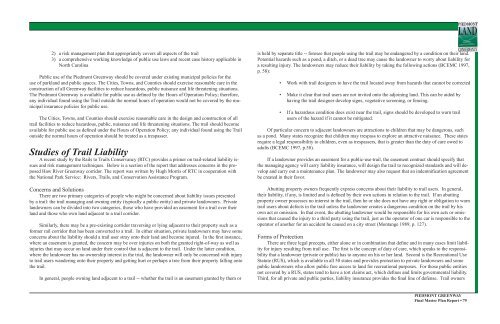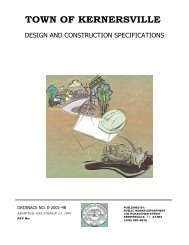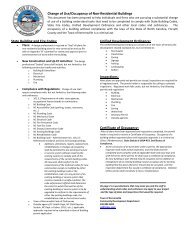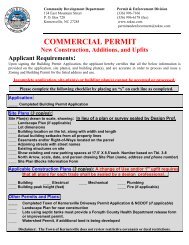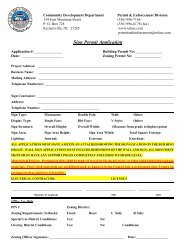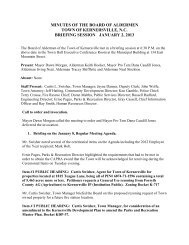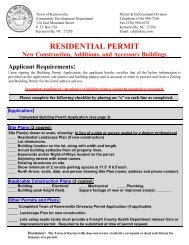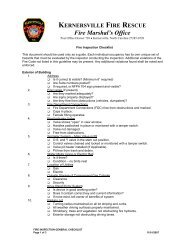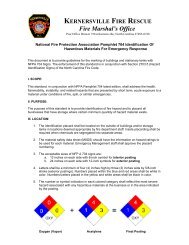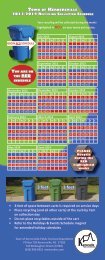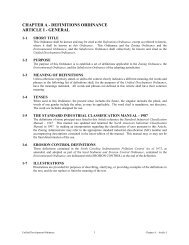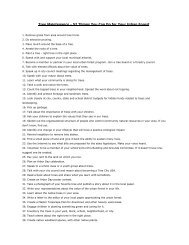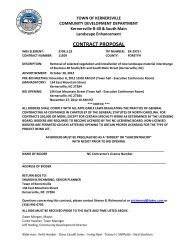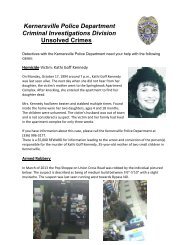Piedmont Greenway Master Plan - Town of Kernersville
Piedmont Greenway Master Plan - Town of Kernersville
Piedmont Greenway Master Plan - Town of Kernersville
- No tags were found...
You also want an ePaper? Increase the reach of your titles
YUMPU automatically turns print PDFs into web optimized ePapers that Google loves.
2) a risk management plan that appropriately covers all aspects <strong>of</strong> the trail<br />
3) a comprehensive working knowledge <strong>of</strong> public use laws and recent case history applicable in<br />
North Carolina<br />
Public use <strong>of</strong> the <strong>Piedmont</strong> <strong>Greenway</strong> should be covered under existing municipal policies for the<br />
use <strong>of</strong> parkland and public spaces. The Cities, <strong>Town</strong>s, and Counties should exercise reasonable care in the<br />
construction <strong>of</strong> all <strong>Greenway</strong> facilities to reduce hazardous, public nuisance and life threatening situations.<br />
The <strong>Piedmont</strong> <strong>Greenway</strong> is available for public use as defined by the Hours <strong>of</strong> Operation Policy; therefore,<br />
any individual found using the Trail outside the normal hours <strong>of</strong> operation would not be covered by the municipal<br />
insurance policies for public use.<br />
The Cities, <strong>Town</strong>s, and Counties should exercise reasonable care in the design and construction <strong>of</strong> all<br />
trail facilities to reduce hazardous, public, nuisance and life threatening situations. The trail should become<br />
available for public use as defined under the Hours <strong>of</strong> Operation Policy; any individual found using the Trail<br />
outside the normal hours <strong>of</strong> operation should be treated as a trespasser.<br />
Studies <strong>of</strong> Trail Liability<br />
A recent study by the Rails to Trails Conservancy (RTC) provides a primer on trail-related liability issues<br />
and risk management techniques. Below is a section <strong>of</strong> the report that addresses concerns in the proposed<br />
Haw River <strong>Greenway</strong> corridor. The report was written by Hugh Morris <strong>of</strong> RTC in cooperation with<br />
the National Park Service: Rivers, Trails, and Conservation Assistance Program.<br />
Concerns and Solutions<br />
There are two primary categories <strong>of</strong> people who might be concerned about liability issues presented<br />
by a trail: the trail managing and owning entity (typically a public entity) and private landowners. Private<br />
landowners can be divided into two categories, those who have provided an easement for a trail over their<br />
land and those who own land adjacent to a trail corridor.<br />
Similarly, there may be a pre-existing corridor traversing or lying adjacent to their property such as a<br />
former rail corridor that has been converted to a trail. In either situation, private landowners may have some<br />
concerns about the liability should a trail user stray onto their land and become injured. In the first instance,<br />
where an easement is granted, the concern may be over injuries on both the granted right-<strong>of</strong>-way as well as<br />
injuries that may occur on land under their control that is adjacent to the trail. Under the latter condition,<br />
where the landowner has no ownership interest in the trial, the landowner will only be concerned with injury<br />
to trail users wandering onto their property and getting hurt or perhaps a tree from their property falling onto<br />
the trail.<br />
In general, people owning land adjacent to a trail -- whether the trail is an easement granted by them or<br />
is held by separate title -- foresee that people using the trail may be endangered by a condition on their land.<br />
Potential hazards such as a pond, a ditch, or a dead tree may cause the landowner to worry about liability for<br />
a resulting injury. The landowners may reduce their liability by taking the following actions (BCEMC 1997,<br />
p. 58):<br />
• Work with trail designers to have the trail located away from hazards that cannot be corrected<br />
• Make it clear that trail users are not invited onto the adjoining land. This can be aided by<br />
having the trail designer develop signs, vegetative screening, or fencing.<br />
• If a hazardous condition does exist near the trail, signs should be developed to warn trail<br />
users <strong>of</strong> the hazard if it cannot be mitigated.<br />
Of particular concern to adjacent landowners are attractions to children that may be dangerous, such<br />
as a pond. Many states recognize that children may trespass to explore an attractive nuisance. These states<br />
require a legal responsibility to children, even as trespassers, that is greater than the duty <strong>of</strong> care owed to<br />
adults (BCEMC 1997, p.58).<br />
If a landowner provides an easement for a public-use-trail, the easement contract should specify that<br />
the managing agency will carry liability insurance, will design the trail to recognized standards and will develop<br />
and carry out a maintenance plan. The landowner may also request that an indemnification agreement<br />
be created in their favor.<br />
Abutting property owners frequently express concerns about their liability to trail users. In general,<br />
their liability, if any, is limited and is defined by their own actions in relation to the trail. If an abutting<br />
property owner possesses no interest in the trail, then he or she does not have any right or obligation to warn<br />
trail users about defects in the trail unless the landowner creates a dangerous condition on the trail by his<br />
own act or omission. In that event, the abutting landowner would be responsible for his own acts or omissions<br />
that caused the injury to a third party using the trail, just as the operator <strong>of</strong> one car is responsible to the<br />
operator <strong>of</strong> another for an accident he caused on a city street (Montange 1989, p. 127).<br />
Forms <strong>of</strong> Protection<br />
There are three legal precepts, either alone or in combination that define and in many cases limit liability<br />
for injury resulting from trail use. The first is the concept <strong>of</strong> duty <strong>of</strong> care, which speaks to the responsibility<br />
that a landowner (private or public) has to anyone on his or her land. Second is the Recreational Use<br />
Statute (RUS), which is available in all 50 states and provides protection to private landowners and some<br />
public landowners who allow public free access to land for recreational purposes. For those public entities<br />
not covered by a RUS, states tend to have a tort claims act, which defines and limits governmental liability.<br />
Third, for all private and public parties, liability insurance provides the final line <strong>of</strong> defense. Trail owners<br />
PIEDMONT GREENWAY<br />
Final <strong>Master</strong> <strong>Plan</strong> Report • 79


